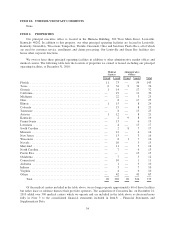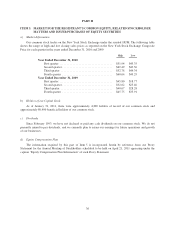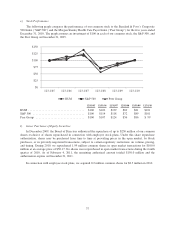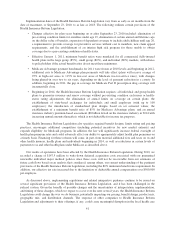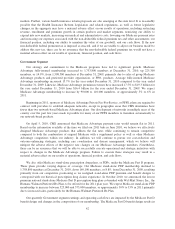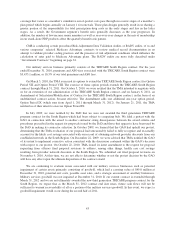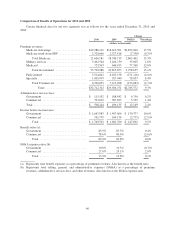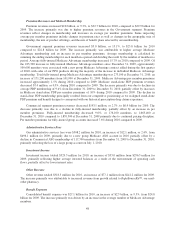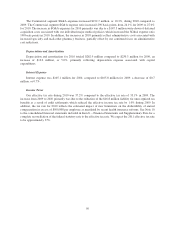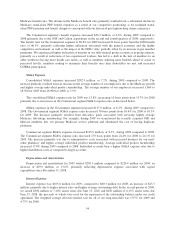Humana 2010 Annual Report Download - page 54
Download and view the complete annual report
Please find page 54 of the 2010 Humana annual report below. You can navigate through the pages in the report by either clicking on the pages listed below, or by using the keyword search tool below to find specific information within the annual report.Commercial Segment
Commercial segment pretax earnings decreased $2.6 million, or 2.5%, for 2010 compared to 2009.
Commercial segment pretax earnings for 2010 were negatively impacted by a $147.5 million write-down of
deferred acquisition costs associated with our individual major medical policies and a net charge of $138.9
million due to reserve strengthening for our closed block of long-term care policies. Excluding these items,
Commercial segment pretax earnings improved year over year due to medical trend that was lower than trend
assumed in pricing, continued pricing discipline, administrative cost reductions, and prior year favorable reserve
releases not in the ordinary course of business. As a result of significant reforms to the U.S. health insurance
industry discussed previously, a substantial portion of deferred acquisition costs associated with our individual
major medical block of business were not recoverable from future income and we recorded a charge to selling,
general, and administrative expense of $147.5 million during 2010 as discussed in Note 18 to the consolidated
financial statements included in Item 8. – Financial Statements and Supplementary Data. During 2010, certain
states approved premium rate increases for a large portion of our long-term care block that were significantly
below our acquisition date assumptions. Based on these actions by the states, combined with the depressed
interest rate environment and increased expenses, we recorded $138.9 million of additional benefit expense in the
fourth quarter of 2010 as discussed in Note 18 to the consolidated financial statements included in Item 8. –
Financial Statements and Supplementary Data. Commercial segment fully-insured medical membership at
December 31, 2010 of 1,633,400 decreased 176,100 members, or 9.6% from December 31, 2009 primarily as a
result of continued pricing discipline. The decreased utilization year-over-year coupled with the favorable reserve
releases led to a lower Commercial segment benefit ratio for 2010. The write-down of deferred acquisition costs,
together with administrative costs associated with increased specialty and mail-order pharmacy business, led to a
higher Commercial segment SG&A expense ratio for 2010.
Other Highlights
• As more fully described on page 66, actuarial standards require the use of assumptions based on
moderately adverse experience, which generally results in favorable reserve development, or reserves
that are considered redundant. When we recognize a release of the redundancy, we disclose the amount
that is not in the ordinary course of business. We experienced prior year favorable reserve releases not
in the ordinary course of business in both our Government and Commercial segments of approximately
$231.2 million in the aggregate, or $0.86 per diluted common share, for the year ended December 31,
2010. This favorable reserve development primarily resulted from improvements in the claims
processing environment and, to a lesser extent, better than originally estimated utilization as well as a
shortening of the cycle time associated with provider claim submissions. We believe we have
consistently applied our methodology in determining our best estimate of benefits payable.
• Operating cash flows increased $820.2 million to $2,241.8 million for the year ended December 31,
2010 compared to $1,421.6 million for the year ended December 31, 2009. The increase primarily was
due to earnings improvement, enrollment activity, and changes in working capital items.
We intend for the discussion of our financial condition and results of operations that follows to assist in the
understanding of our financial statements and related changes in certain key items in those financial statements
from year to year, including the primary factors that accounted for those changes.
Recent Acquisitions
On December 21, 2010, we acquired Concentra Inc., or Concentra, a health care company based in Addison,
Texas, for cash consideration of $804.7 million. Through its affiliated clinicians, Concentra delivers occupational
medicine, urgent care, physical therapy, and wellness services to workers and the general public through its
operation of medical centers and worksite medical facilities. The Concentra acquisition provides entry into the
primary care space on a national scale, offering additional means for achieving health and wellness solutions and
providing an expandable platform for growth with a management team experienced in physician asset
management and alternate site care.
44


